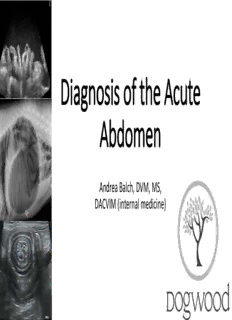
Diagnosis of the Acute Abdomen PDF
Preview Diagnosis of the Acute Abdomen
Diagnosis of the Acute Abdomen Andrea Balch, DVM, MS, DACVIM (internal medicine) What does “acute abdomen” mean? • Sudden onset of intense abdominal pain arising from sites within or outside the abdominal cavity Pain • Three possible types of abdominal pain • Visceral • Somatic • Referred Pain • In the abdomen, nociceptive fibers are only found: • In the wall and/or capsule of organs • Majority of organ tissue is not innervated • In the connective tissue of the parietal peritoneum • “Visceral pain” • Organs • Predominantly C fibers • Low conduction velocity • Highly sensitive to distension (stretch), ischemia and inflammation • Relatively insensitive to other stimuli that normally evoke pain such as cutting or burning • Slow, dull, difficult to localize pain • “Somatic pain” • Peritoneum, skin, musculature • A and C fibers • Faster conduction • Respond to lower levels of stimulation • A fibers respond to mechanical and thermal stimuli and trigger rapid, sharp, localizable pain Referred pain • Pain may also be referred from other areas • IVDD dogs • Soft tissue injury to thoracic musculature may have referred abdominal pain Signs • Signs of abdominal pain include • Restlessness • Stiff gait • Hunched back • Prayer position • Abdominal distention • Tachypnea • Tachycardia • Anorexia • Hypersalivation • Vomiting • Lethargy Acute abdomen syndrome • Patients with acute abdominal pain can have multi-organ signs • Other associated signs include: • Dyspnea • Arrhythmia • Altered mentation • Hypotension • Shock • Cardiorespiratory arrest Acute abdomen syndrome • Many patients have severe vomiting and/or diarrhea which lead to hypovolemia • Many causes of abdominal pain have significant cardiovascular and respiratory effects leading to rapid patient decompensation • Painful stimuli cause tachycardia and vasoconstriction which exacerbates an already shocky patient condition Diagnostic challenge • Critical patient • Requires immediate life saving stabilization • Requires quick diagnosis • Does the patient need surgery? Typical order of evaluation 1. Signalment 1. Triage 2. Comprehensive history 2. Fluid resuscitation 3. Comprehensive PE 3. Signalment 4. Clin path 4. Comprehensive PE 5. Imaging 5. Analgesics 6. Treatments 6. Comprehensive history a) Analgesics 7. Clin path b) fluids 8. Imaging
Description: